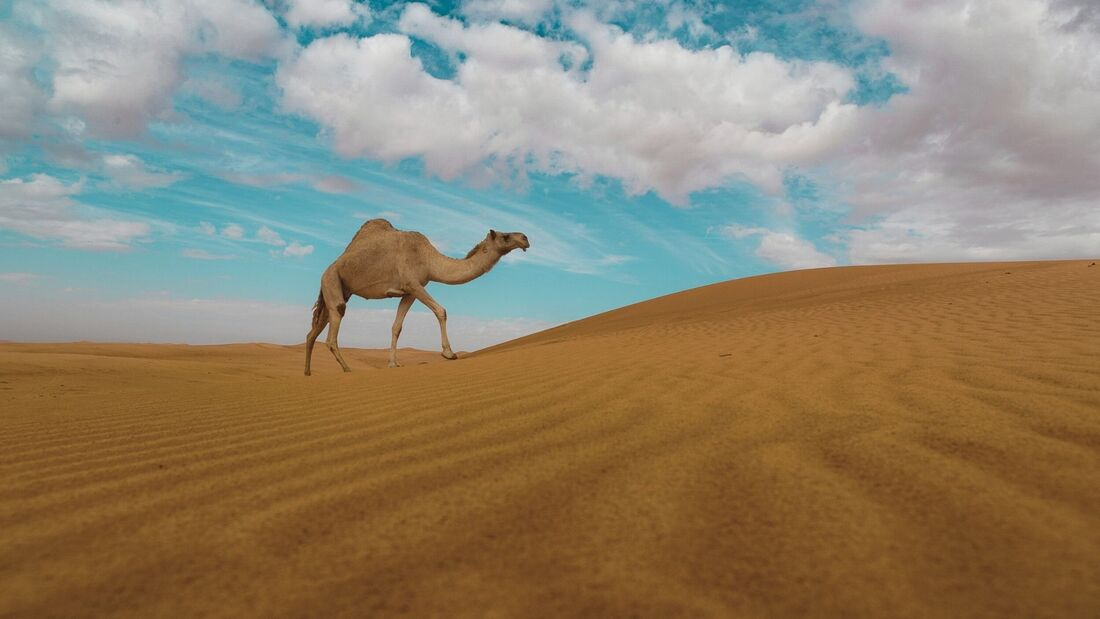Surviving the Sandstorm: How Camels Are Shaping Saudi Arabia’s Climate Future

Photo by Saleh Al-Hathloul
As the planet heats up and deserts expand, the world is racing to find answers. In the Middle East, where water is scarce and heat is relentless, one ancient creature is stepping into the spotlight—not just as a survivor, but as a symbol of a smarter, more sustainable future.
Meet the camel.
Long revered in Arab culture, the dromedary camel (Camelus dromedarius) is now being seen through a new lens—as a critical partner in Saudi Arabia’s climate strategy. Thanks to groundbreaking efforts like CamelX, this iconic desert animal is being reimagined as a key asset in agriculture, health, and innovation.
Desert-Built. Climate-Ready.
Camels are natural-born climate champions. Built for brutal heat and parched landscapes, they can go days without water, handle internal body temperatures of up to 41.7°C, and survive water losses that would be fatal to most animals (Schmidt-Nielsen et al., 1956).
What makes them truly extraordinary in the age of climate change?
- They use far less water to produce milk than cows or
- They release fewer greenhouse gases per kilogram of body
- They thrive on poor-quality, saline, or arid vegetation most animals
In short, camels offer nutrition, medicine, and meat—while treading lightly on the planet. For a future shaped by climate extremes, that’s a game-changer.
A Cleaner Kind of Cattle
Here’s a startling fact: livestock is responsible for 14.5% of global greenhouse gas emissions, mostly from ruminants like cows (Gerber et al., 2013). These animals burp out methane—a greenhouse gas 25 times more powerful than carbon dioxide.
But camels? They’re different.
Thanks to their unique three-chambered stomachs and distinct microbial systems, camels emit far less methane than cows (Dittmann et al., 2014). That makes camel farming a far more climate-friendly choice—and one that fits perfectly with Saudi Arabia’s Green Initiative, which targets net-zero emissions by 2060.
The Superfood Hiding in Plain Sight
Camel milk isn’t just a traditional drink—it’s a nutritional powerhouse. Rich in immune-boosting proteins, insulin-like peptides, and healthy fats, it’s long been known for its healing properties (El-Agamy, 2009).
But here’s the twist: it takes two to five times less water to produce than cow milk. In a country where more than 80% of food is imported, camel milk represents a rare opportunity—a locally sourced, climate-resilient superfood.
Saudi scientists are already pushing boundaries, working on:
- New forms of medicinal nutrition
- Shelf-stable dairy products for remote and arid regions
- Locally made functional foods to reduce reliance on imports
Guardians of the Ecosystem
Camels are more than milk producers—they’re stewards of the desert. Their grazing helps maintain ecological balance by preventing overgrowth and spreading seeds. For nomadic and semi-nomadic communities, they also preserve traditional lifestyles and knowledge.
Encouraging sustainable camel herding could:
- Protect regional genetic breeds with rare adaptive traits
- Create camel-based rural economies that fight poverty
- Boost ecotourism and cultural preservation tied to desert life
Through CamelX, Saudi Arabia is also gathering valuable genetic data—helping guide conservation efforts that are both rooted in science and respectful of cultural heritage.
A New Frontier in Health Innovation
The camel’s secrets don’t stop at sustainability. Its immune system and metabolism hold keys to the future of medicine. Scientists are now studying camel-derived nanobodies—tiny, heat-stable molecules that could be used in vaccines and diagnostics without refrigeration.
And in areas where chronic illnesses are rising, camel milk peptides are showing anti-inflammatory and anti-diabetic effects (Malik et al., 2012). These properties make camels part of a bigger vision: delivering affordable, low-carbon healthcare where it’s needed most.
From the Sands, A Vision
Sustainability isn’t just about saving the planet. It’s about building systems that can bend without breaking—systems that can thrive under pressure.
That’s where the camel shines.
With the right investment in biotechnology, nutrition, and camel-based agriculture, Saudi Arabia has the chance to:
- Strengthen local food and health supply chains
- Export desert-tested solutions to countries facing similar threats
- Pioneer scientific innovation grounded in regional ecosystems
At its heart, CamelX is more than a research program. It’s a vision of resilience, rooted in tradition and driven by science. In a world warming fast, the camel is no longer just surviving the sandstorm—it’s helping shape what comes next.
References
- Dittmann, T., Runge, U., Lang, R. A., et al. (2014). Methane emissions from camels: A comparison with ruminants.
PLOS ONE, 9(5), e94363.
- El-Agamy, I. (2009). Bioactive components in camel milk. In Milk and Dairy Products in Human Nutrition (pp. 159–171). Wiley-Blackwell.
- Gerber, J., et al. (2013). Tackling Climate Change Through Livestock. FAO.
- Malik, , Al-Senaidy, A., Skrzypczak-Jankun, E., & Jankun, J. (2012). A study of the anti-diabetic agents of camel milk.
International Journal of Molecular Medicine, 30(3), 585–592.
- Schmidt-Nielsen, , et al. (1956). Water conservation in the camel. Physiological Reviews, 36(2), 203–229.
